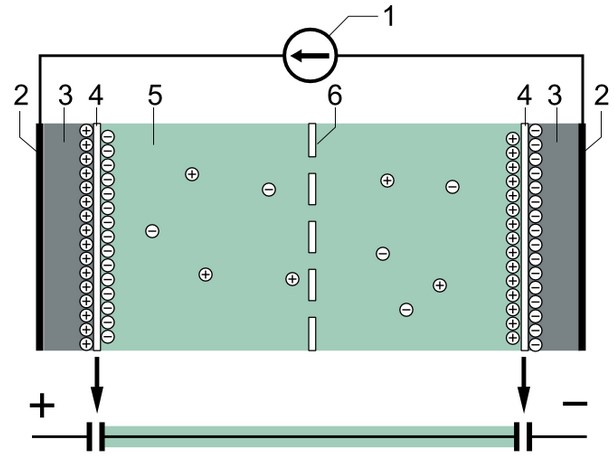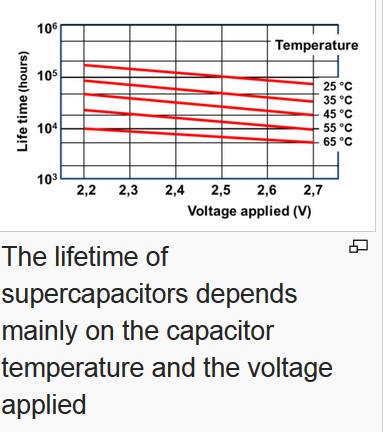Supercapacitors have their place in modern electronic systems, especially if you are cycling the charge in them frequently or need to carry a very large current load.
Capacitors are used in all designs, as decoupling is mandatory in most designs in order to filter any noise or create an oscillator. For these capacitors, a larger value is expressed in microfarad, while smaller values are denoted in picoFarad. The unit for supercap is in the range of Farads. Thanks to its high capacity, it can compete against batteries when a few hours of back-up are required. They can also work in conjunction with batteries to provide high levels of power for a short amount of time. With high current capabilities, it can also be used in energy harvesting applications like braking and energy recovery systems in hybrid vehicles.
In order to reach high values, supercapacitors cannot use the technology used in standard capacitors.
There are several types of supercap technologies that can be used, but the most widely adopted is known as the double-layer capacitor. The internal organic electrolyte is easy to manufacture and is safer than lithium-ion batteries, for instance.
A supercapacitor’s structure is like having 2 capacitors in series. Two electrodes (3) sandwiched between collectors (2) are separated by an ion-permeable membrane (6) with an electrolyte (5) connecting both electrodes. When the electrodes are polarized by an applied voltage (1), ions in the electrolyte form an electric double layer (4) that is of opposite polarity to the electrode’s polarity. This mechanism explains the name of double layer capacitors.

It is possible for the distance between the two charge layers to be extremely small, meaning that very high capacitance levels are achievable.
There are two types of double layer capacitor resulting from different charge storage mechanisms:
- Electrical double-layer capacitor: an EDLC stores energy in the double-layer at the electrode/electrolyte interface. In this type of capacitor the electrode material used for the construction of the cell is mainly carbon material
- Electrochemical double layer capacitor or pseudo-capacitor: the supercapacitor sustains a faradic reaction between the electrode and the electrolyte in a suitable potential window. In this type of supercapacitor, the electrode material consists of either transition metal oxides or mixtures of carbon and metals of oxides/polymers
A supercap has characteristics that are different from those of a standard capacitor, and a few points are worthy to note:
- Maximum voltage: the maximum voltage is lower than standard capacitors and is often in the range of 2.5V. It is possible to have supercaps with higher voltages, but the lifetime can be shortened.
- The lifetime is limited by the rate of evaporation of the liquid electrolyte. This evaporation is a function of temperature, current load, current cycle frequency, and voltage. As shown below, the lifetime can range from one year to more than 10 years, depending on how it is used.

- In order to achieve higher operation voltages for supercapacitors, you can place them in series, also known as stacks.
- Self-discharge: the energy stored can decrease by 50% in a month. This means the supercap must be recharged regularly even if it did make any back-up at all.
Now that we have looked at what a supercap is and how it is constructed, let’s explore the idea of using them as a replacement for standard battery applications. How do we size them to compare their run times with some of their unique characteristics and what unique strengths do they have?
One thing to keep in mind as we look at the energy capacity of a supercapacitor is that there is a large difference between the maximum energy capacity and the effective energy capacity. The difference between effective and maximum energy is determined by how low a voltage the system can utilize and the design of the supercapacitor, which dictates its minimum voltage. Supercapacitors don’t drain like batteries in the sense that there is a relatively stable voltage output as the capacity drains. In a lithium ion battery, you can expect close to 3.7 volts over a large range of the battery capacity, but with a supercapacitor you will see the voltage drop quickly as energy is drained. Sometimes this voltage drop can look almost linear over time when current output is held constant.
With the voltage drop in mind, the maximum energy capacity is found using the equation Wmax = ½ * Ctotal * V2loaded * 1/3600 where W would be the watts stored, C is the total capacitance of the supercap, and V is the supercap voltage when it is fully charged. This method to measure the capacity can be deceiving, though, as we noted above that the supercap’s effective energy must be measured with regards to the minimum voltage of the system. To measure the effective energy capacity, we use the formula Weff = ½ * Ctotal * (V2max - V2min) * 1/3600.

Here is a little example using an obscenely large super capacitor. I picked the 3000F Eaton Powerstor XL60 to demonstrate what happens as I increase the minimum system voltage and how much useful capacity we lose. And yes, that really is 3000 Farads in a single supercap, it wasn’t a typo.
관련 상품 참조
If the system design using this supercap can only support a minimum input of 1.6V, then it has lost 1/3rd of the potential energy stored within the supercap. The impact from this can be taken into account when designing a power input stage with a wider input voltage boost circuit, but you have to recognize the limitations ahead of time. Also, as you decrease the voltage out of the supercap, you need to increase the current output to maintain a constant power output stressing the circuit elements more.

Energy capacity may be a bit of a letdown, but the supercap does manage to shine in power density, meaning they can handle very large surge currents. The capacity to handle peak current loads is part of the capacitor portion of the supercap. This ability is one of the reasons supercaps have found a home in battery powered cordless tools, providing a buffer for high current surges to help power that last screw into place or to make sure there is enough torque on a blade for a strong and clean cut.
From our example above, we can look at the same Eaton XL60. Once you dive into the datasheet, you can see that it will handle 140A continuous output, but what is really eye opening is the peak current rating of 2400A. The current handling is what really sets supercaps apart from lithium-ion batteries. Even smaller supercaps such as the JUMT1106MHD from Nichicon (which comes in at 10F) can handle up to 5A peak current, and it even has an automotive rating for a wider range of temperatures.
관련 상품 참조
Another strength the supercap has over batteries is capacity fade. As you cycle lithium ion cells, they take wear and they lose capacity over time, leading to a reduction of their useful life – many times they are rated for 300-500 cycles. Supercapacitors do not suffer as much from the same cycle effects, and for the previous Eaton XL60, it loses less than 20% of its capacitance after 1,000,000 cycles. Along with this great cycle performance, you also generally see wider useful temperature ranges in supercaps.
Supercapacitors have their place in modern electronic systems, especially if you are cycling the charge in them frequently or need to carry a very large current load. Definitely look at them as an addition to regular battery systems and sometimes as an outright replacement.




